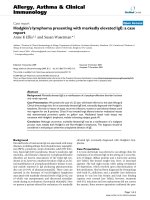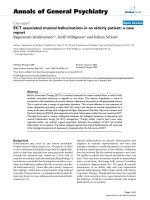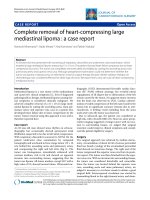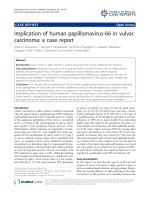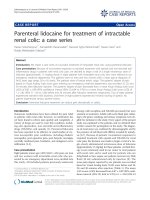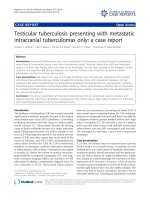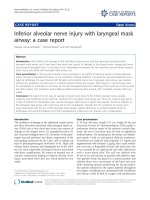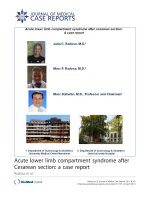Báo cáo y học: "Acute lower limb compartment syndrome after Cesarean section: a case report" pps
Bạn đang xem bản rút gọn của tài liệu. Xem và tải ngay bản đầy đủ của tài liệu tại đây (966.44 KB, 4 trang )
JOURNAL OF MEDICAL
CASE REPORTS
Acute lower limb compartment syndrome after
Cesarean section: a case report
Radosa et al.
Radosa et al. Journal of Medical Case Reports 2011, 5:161
(22 April 2011)
CAS E RE P O R T Open Access
Acute lower limb compartment syndrome after
Cesarean section: a case report
Julia C Radosa
1†
, Marc P Radosa
2*†
and Marc Sütterlin
1
Abstract
Introduction: Acute compartment syndrome of the lower limb is a rare but severe intra- and post-partum
complication. Prompt diagnosis is essential to avoid permanent functional restriction or even the loss of the
affected limb. Clinical signs and symptoms might be nonspecific, especially in the early stages; therefore,
knowledge of predisposing risk factors can be helpful.
Case presentation: We present the case of a 32-year-old Caucasian woman with acute post-partum compartment
syndrome.
Conclusion: Acute compartment syndrome is an important differential diagnosis for the sudden onset of intra- or
post-partum lower-limb pain. Predisposing factors for the manifestation of acute compartment syndrome in an
obstetric environment are augmented intra-partum blood loss, prolonged hypotensive episodes and the use of
oxytocin to support or induce labor because of its vasoconstrictive properties. Treatment is prompt surgical
decompression by performing fasciotomy in any affected muscular compartments.
Introduction
Acute limb compartment syndrome (ACS) is a condition
in which increased pressure within a closed musculofas-
cial compartment compromises blood circulation and
biomechanical function. There are se veral etiologies of
ACS. ACS may occur after significant trauma, for exam-
ple, long-bone fractures. Other forms of injury which
cause soft tissue damage, such as crush injuries, severe
thermal burns and bleeding diathesis are known causes
as well. Less frequently ACS may occur in a non-
traumatic setting, such as in post-ischemic reperfusion,
in revascularization procedures, after the application of
vasoconstrictive therapeutic agents or in anesthesia-
induced hypotension [1]. An iatrogenic cause, prolonged
limb compression occurring in surgical procedures
carried out with the patient in the lithotomy position
(the Lloyd-Davies position), has been described in the
literature [2].
Pathophysiologically, the expansion of tissue in a closed
muscle compartment in ACS leads to an increase in
pressure, which subsequently causes compression of
thin-walled veins within that compartment [3]. As a
result, venous outflow decreases and veno us and arterial
intra-vasal pressure increa se, which causes diminished
perfusion of the affected compartment [4]. The conse-
quences of this insufficient perfusion are nerve and mus-
cle ischemia. Muscle infarction and lasting nerve damage
will occur if prompt surgical decompression is delayed.
ACS is diagnosed on the basis of clinical evaluation. In
cases with an atypical or unclear clinical presentation,
the invasive measurement of compartment pressure
might be helpful [5]. Continuous monitoring of tissue
oxygen saturation using near infrared spectroscopy has
been described as particularly helpful in the diagnosis of
ACS, because a sudden decrease in tissue oxygen satura-
tion might be a first warning sign [6].
Severe pain, which appears to be out of proportion in
relation to the apparen t injury, is often the major clinical
sign of ACS. Pain on passive stretch of the muscles and
tenseness are further clinical signs frequently encoun-
tered in ACS. In the late stage of ACS, sensory deficits,
paresthesias, muscle weakness, paralysis, pallor and pul-
selessness are typical features [7]. Definitive treatment for
patients with ACS consists of decompression of the
affected compartment by performing surgical fasciotomy.
* Correspondence:
† Contributed equally
2
Department of Gynecology & Obstetrics, Jena University Hospital, Jena,
Germany
Full list of author information is available at the end of the article
Radosa et al. Journal of Medical Case Reports 2011, 5:161
/>JOURNAL OF MEDICAL
CASE REPORTS
© 2011 Radosa et al; licensee BioMed Central Ltd. This is an Open Access arti cle distributed under the terms of the Creative Commons
Attribution License ( s/by/2.0), which permits unrestricted use, distribution, and reproductio n in
any medium, provided the original work is properly cited.
Case presentation
A 32-year-old primigravida Caucasian woman came to
our department at 38 weeks and four days of gestation
with spontaneous onset of labor and rupture of mem-
branes after an uncomplicated pregnancy. The patient
received an oxytocin infusion (Oxytocin 10 I.E., Oxyto-
cin Hexal, Hexal AG, 83607 Holzkirchen, Germany) in
250 ml of 0.9% NaCl for labor stimulation, and an epi-
dural catheter for anesthesia was applied. Seven hours
after the patient was admitted to the hospital, we opted
to perform a Cesarean section because of failure to pro-
gress in the first stage of labor and a non-reassuring
fetal heart rate during continuous cardiotocography
monitoring. A Cesarean section was performed wit hout
intra-operat ive complications, and a healthy male infant
was delivered.
Five hours after the intervention and the patient’ s
readmission to the hospital ward, the patient com-
plained of a spasm-like pain in her right lower leg. An
exami nation revealed mild tenseness and swelling of the
right pretibial region. A Doppler ultrasound examination
performed to exclude deep venous thrombosis showed
no remarkable findings. Hence analgesic trea tment with
paracetamol (1000 mg oral) and piritramide (15 mg in
250mlof0.9%NaClintra-venous)wasstarted.How-
ever, the patient’ s symptoms did not improve, and she
was re-examined one hour after the onset of her initial
symptoms. The tenseness a nd swelling had now pro-
gressed, and measurement of her calf diameters showed
a difference of 1 cm between the right and left calves.
No sensory deficit was noted, her pedal pulses were
palpable on both sides and her tendon reflexes were
symmetr ical. However, a discr ete weakness of flexion of
the right foot was observed, which led to the clinical
suspicion of ACS. The patient was taken to the surgi cal
theater, and ACS of the anterior tibial compartment was
found during surgical explorat ion. A fasciotomy without
resection of muscular tissue was subsequen tly carried
out. After the surgical intervention, the patien t reported
immediate relief of t he initial symptoms. Secondary
wound closure of the open fasciotomy was performed
within the following 10 post-operative days using a
shoelace technique, and after 11 days the patient could
be released to out-patient care. Moderate weakness of
greattoeextensionandflexionintherightanklejoint,
still present at the time of discharge, continued to be
treated with physical therapy in our out-patient dep art-
ment. A full functional recovery of the limb w as
achieved within 15 days of discharge.
Discussion
ACS is a complication which usually occurs in the set-
ting of a traumati c injury or as a pos t-operative compli-
cation after prolonged surgical procedures. Several risk
factors for the manifestation of ACS have been
described, including p rolonged hypotensive episodes,
fluid deficit, treatment with vasoconstrictive agents, vas-
cular occlusion, lying in t he lithotomy position, pro-
longed surgery t ime, the use of compressive ba ndages
and obesity [8]. In obstetrics, ACS is a relatively rare
complication: Its prevalence has been estimated to be
within two per 10,000 births [9].
Most ACS in obstetric patients described in the litera-
ture occurred in the setting of Cesarean delivery [8,9].
Interestingly, in all of these c ases, the Cesarean section
was initially co mplicated by a massive blood loss
because of disseminated intra-vascular coagulopathy.
ACS has also been reported following vaginal delivery
[10]. In these cases, ACS occurred in the s etting of a
retained placenta leading to hypovolemic shock due to
extensive blood loss.
Most authors consider a combination of factors to
be causes of post-partum ACS, such as augmented
intra-partum blood loss, prolonged hypotensive epi-
sodes and the use of oxytocin to support or induce
labor, owing to its vasoconstrictive properties [11].
Several of thes e described risk fac tors were present in
our patient. We used oxytocin to support labor, and
the patient underwent epidural anesthesia with the
possibility of an unnoticed hypotensive episode, since
we did not monitor the p atient’ sbloodpressurecon-
tinuously and the delivery was performed by Cesarean
section. It is difficult to further clarify the role of
these factors and their contribution to the develop-
ment of ACS in our patient ex post facto.However,
the knowledge of these predisposing factors for p ost-
partum ACS can be a valuable help in correctly inter-
preting the often unspecific early clinical symptoms of
this entity, since diagnostic delay might jeopardize the
therapeutic outcome.
Conclusion
ACS is a rare but severe complication which can occur
during and after labor. Because the fun ctional outcome
after ACS is directly related t o undelayed surgical inter-
vention, it is es sential to be aware of ACS in the differ-
ential diagnosis in patients with severe intra- and post-
partum lower-limb pain.
Consent
Written informed consent was obtained from the patient
for publicatio n of this case report and any accompany-
ing images. A copy of the written consent is available
for review by the Editor-in-Chief of this journal.
Acknowledgements
The authors thank Professor Ingo Bernard Runnebaum, MD and Professor
Ekkehard Schleussner, MD for their medical expertise. Further the authors
Radosa et al. Journal of Medical Case Reports 2011, 5:161
/>Page 2 of 3
thank Barbara Foote and Missy Frey, medical students, for assistance in
elaboration of the manuscript.
JCR was funded by a stipend of the University Medical Center Mannheim,
University of Heidelberg, Germany.
Author details
1
Department of Gynecology & Obstetrics, University Medical Center
Mannheim, University of Heidelberg, Theodor-Kutzer Ufer 1-3, D-68167
Mannheim, Germany.
2
Department of Gynecology & Obstetrics, Jena
University Hospital, Jena, Germany.
Authors’ contributions
JCR and MPR contributed equally to the preparation of this manuscript. MS
supervised the clinical care of the patient and the preparation of this
manuscript as the medical head of our department. All authors read and
approved the final manuscript.
Competing interests
The authors declare that the y have no competing interests.
Received: 10 October 2010 Accepted: 22 April 2011
Published: 22 April 2011
References
1. Tiwari A, Haq AI, Myint F, Hamilton G: Acute compartment syndromes. Br
J Surg 2002, 89:397-412.
2. Tomassetti C, Meuleman C, Vanacker B, D’Hooghe T: Lower limb
compartment syndrome as a complication of laparoscopic laser surgery
for severe endometriosis. Fertil Steril 2009, 92:2038.e9-e12.
3. Krarup PM, Rawashdeh YF: [Lower limb compartment syndrome following
laparoscopic sigmoid resection in the lithotomy position] [in Danish].
Ugeskr Laeger 2008, 170:1543-1544.
4. Dente CJ, Wyrzykowski AD, Feliciano DV: Fasciotomy. Curr Probl Surg 2009,
46:779-839.
5. Lagerstrom CF, Reed RL, Rowlands BJ, Fischer RP: Early fasciotomy for
acute clinically evident posttraumatic compartment syndrome. Am J Surg
1989, 158:36-39.
6. Arató E, Kürthy M, Sínay L, Kasza G, Menyhei G, Masoud S, Bertalan A,
Verzár Z, Kollár L, Roth E, Jancsó G: Pathology and diagnostic options of
lower limb compartment syndrome. Clin Hemorheol Microcirc 2009, 41:1-8.
7. Gourgiotis S, Villias C, Germanos S, Foukas A, Ridolfini MP: Acute limb
compartment syndrome: a review. J Surg Educ 2007, 64:178-186.
8. Byers BD, Silva PH, Kost ER: Delivery complicated by postpartum
hemorrhage and lower extremity compartment syndrome. Obstet
Gynecol 2007, 109:507-509.
9. Lecky B: Acute bilateral anterior tibial compartment syndrome after
caesarian section in a diabetic. J Neurol Neurosurg Psychiatry 1980,
43:88-90.
10. Jyothi NK, Cox C: Compartment syndrome following postpartum
haemorrhage. BJOG 2000, 107:430-432.
11. Leighton BL, Halpern SH: The effects of epidural analgesia on labor,
maternal, and neonatal outcomes: a systematic review. Am J Obstet
Gynecol 2002, 186(5 Suppl Nature):S69-S77.
doi:10.1186/1752-1947-5-161
Cite this article as: Radosa et al.: Acute lower limb compartment
syndrome after Cesarean section: a case report. Journal of Medical Case
Reports 2011 5:161.
Submit your next manuscript to BioMed Central
and take full advantage of:
• Convenient online submission
• Thorough peer review
• No space constraints or color figure charges
• Immediate publication on acceptance
• Inclusion in PubMed, CAS, Scopus and Google Scholar
• Research which is freely available for redistribution
Submit your manuscript at
www.biomedcentral.com/submit
Radosa et al. Journal of Medical Case Reports 2011, 5:161
/>Page 3 of 3
